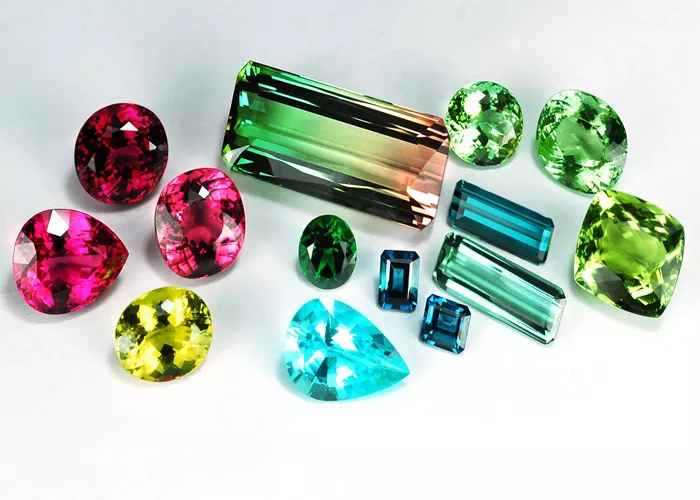Tourmaline, a fascinating gemstone known for its wide range of colors and unique electrical properties, has captivated gemologists and jewelry enthusiasts for centuries. With its versatility in hues from deep reds and blues to vibrant greens and blacks, tourmaline offers a treasure trove of options for jewelry enthusiasts. Understanding the classification of tourmaline grades is crucial for making an optimal choice when purchasing or investing in this captivating gemstone. This article aims to provide a detailed and logical introduction to the grading system of tourmaline, helping readers make informed decisions.
The Basics of Tourmaline
Tourmaline belongs to the silicate mineral group and is characterized by its complex crystal structure and rich color palette. It is found in various geological environments, primarily in pegmatites, metamorphic rocks, and volcanic rocks. The name “tourmaline” is derived from the Sinhalese word “turmali,” meaning “mixed stones,” reflecting its ability to occur in a multitude of colors.
Tourmaline’s popularity stems not only from its beauty but also from its relative abundance compared to other rare gemstones like emerald and sapphire. However, like any gemstone, the quality and value of tourmaline vary significantly based on its grade.
Classification of Tourmaline Grades
When grading tourmaline, gemologists consider several factors, including color, clarity, cut, and carat weight. These factors collectively determine the gemstone’s overall quality and, consequently, its value.
1. Color
Color is the most critical factor influencing the value of tourmaline. Tourmaline occurs in almost every color of the rainbow, but certain shades are more highly valued than others. Here’s a breakdown of the most sought-after colors:
Pink and Red Tourmaline (Rubellite): Ruby-red tourmaline, often referred to as rubellite, is the most valuable color variety. The deeper and more vivid the red, the higher the value. Rubellite is particularly rare and highly esteemed in the gemstone world.
Green Tourmaline (Verdelite): Green tourmaline, or verdelite, ranges from pale green to deep emerald-like hues. The most valuable verdelite is a vibrant, emerald-green color.
Blue Tourmaline (Indicolite): Indicolite is tourmaline’s blue variety, ranging from light sky blue to deep, intense blue. Like rubellite, the deeper and more saturated the blue, the higher the value.
Bipartite and Tripartite Tourmaline: These are tourmaline crystals that exhibit two or three distinct colors. These unique gemstones are highly sought after for their rarity and aesthetic appeal.
Watermelon Tourmaline: Characterized by a center of pink or red surrounded by green, watermelon tourmaline is a visually striking variety, though it may not fetch the same prices as the more uniformly colored varieties.
Black Tourmaline (Schorl): Black tourmaline, particularly schorl, is the most common variety. While it is less valuable than the colored varieties, it is still used in jewelry for its unique properties and dark aesthetic.
2. Clarity
Clarity refers to the absence of inclusions or flaws within the gemstone. Tourmaline can contain various inclusions, such as liquid-filled cavities, crystals, or fractures. The fewer and less obtrusive these inclusions, the higher the clarity grade and, consequently, the value of the gemstone.
Gemologists assess clarity using a 10x loupe or microscope, grading tourmaline on a scale from flawless (very rare) to heavily included. Highly included tourmaline may still be used in jewelry, but it typically fetches a lower price.
3. Cut
The cut of a tourmaline refers to its shape, proportions, and polish. A well-cut tourmaline maximizes its brilliance and fire, enhancing its visual appeal. Gem cutters aim to create a balance between retaining carat weight and achieving optimal beauty.
Standard Shapes: Round, oval, cushion, and emerald cuts are common for tourmaline, as they showcase the gemstone’s color and clarity effectively.
Fancy Shapes: Unique cuts like cabochons, trillions, and marquise can add a distinctive touch to jewelry designs. Cabochons are particularly popular for watermelon and other multicolored tourmalines, as they highlight the stone’s color zones.
Custom Cuts: For high-end jewelry, custom cuts can be designed to emphasize a tourmaline’s unique characteristics, enhancing its overall appeal.
4. Carat Weight
Carat weight is a straightforward measure of a gemstone’s size. Like most gemstones, larger tourmalines are generally more valuable, assuming all other factors (color, clarity, cut) remain constant. However, size is not the sole determinant of value; a smaller, well-cut, and vividly colored tourmaline can fetch a higher price than a larger, poorly cut, or duller stone.
Optimal Choice: Factors to Consider
When choosing the optimal tourmaline for your needs, consider the following factors:
Budget: Determine your budget before shopping. Tourmaline can range from affordable to highly valuable, depending on its grade.
Purpose: Are you looking for a daily wear piece, an investment, or a special occasion gemstone? Your choice will influence the quality and type of tourmaline you select.
Style Preferences: Consider your personal style and the type of jewelry you prefer. Tourmaline can be set in rings, pendants, earrings, and bracelets, each requiring different considerations for size, shape, and setting.
Color Preferences: Tourmaline’s color palette is vast. Choose a color that speaks to you and complements your wardrobe.
Durability: While tourmaline is a relatively durable gemstone (ranking 7-7.5 on the Mohs scale), certain cuts and settings may require more care than others. Consider your lifestyle and how much maintenance you’re willing to invest in your gemstone.
Conclusion
Tourmaline’s diverse color palette and unique properties make it a highly versatile gemstone for jewelry enthusiasts. Understanding the classification of tourmaline grades is essential for making an informed choice when purchasing or investing in this beautiful gem. By considering factors such as color, clarity, cut, and carat weight, you can select a tourmaline that not only meets your aesthetic preferences but also aligns with your budget and lifestyle.
Related topic:
- What Are the Benefits of Pink Tourmaline
- Is Pink Tourmaline UV Reactive
- Can I Keep Black Tourmaline in My Pocket


